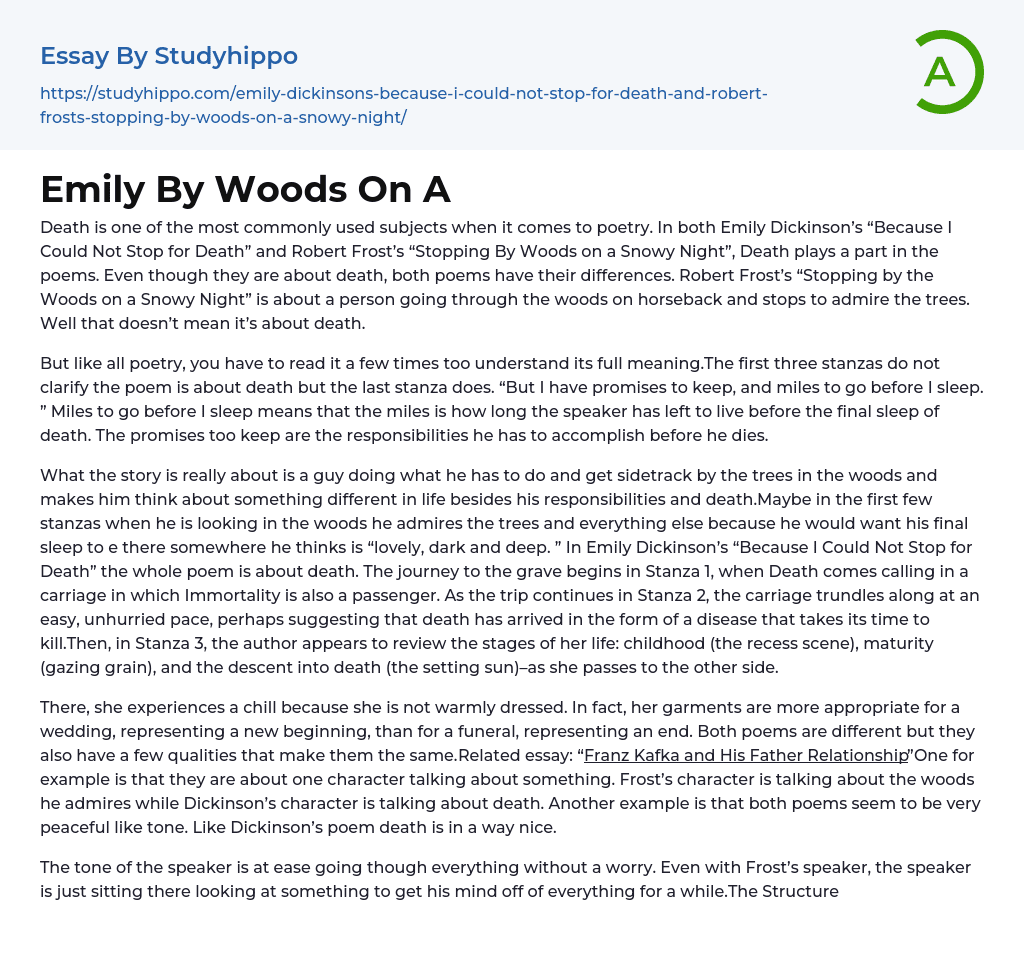Death is a popular theme in poetry and is present in both Emily Dickinson’s “Because I Could Not Stop for Death” and Robert Frost’s “Stopping By Woods on a Snowy Night”. However, although both poems deal with death, they have distinct differences. While Frost’s poem depicts a person on horseback stopping to appreciate the surrounding trees, it does not necessarily allude to the topic of death.
Reading this poem several times is necessary to fully comprehend its meaning as with all poetry. While the first three stanzas do not explicitly mention death, the final stanza reveals the theme. The phrase “But I have promises to keep, and miles to go before I sleep” implies that the speaker has a finite amount of time left to live before the ultimate sleep of death. The promises that must be ful
...filled refer to the tasks and duties that must be completed before passing on.
The story centers around a man who becomes distracted by the trees in the woods while carrying out his duties, leading him to contemplate different aspects of life, including death. The opening stanzas express his admiration for the beauty of the forest, with a desire for it to be his final resting place. In Emily Dickinson's "Because I Could Not Stop for Death," the focus is entirely on death. The journey to the grave begins in the first stanza when Death arrives in a carriage alongside Immortality. The carriage moves slowly, suggesting death may take its time to arrive. In the third stanza, the author reflects on her life as she transitions towards death, with imagery of her childhood, maturity, and eventual descent into death
Experiencing a chill due to inadequate dressing, she realizes that her attire is more fitting for a wedding depicting a beginning rather than a funeral signifying an end. The two poems are distinctive, yet share similarities such as both being monologues by a single character exploring a topic. Frost admires the woods while Dickinson contemplates death. Another likeness is the peaceful tone common to both compositions; death, as explored in Dickinson's poem, is spoken of in a positive light.
Related essay: "
Franz Kafka and His Father Relationship
"
Both poems have a laid-back speaker, casually observing their surroundings to find solace. Despite Dickinson's having more stanzas, both poems share a similar structure featuring four-line quatrains in iambic tetrameter. Overall, these are truly excellent pieces of poetry worth exploring.
Although they exhibit differences, both poems share similarities and are extraordinary to read. In fact, all poems have their unique value and worth reading, if only one takes a moment to comprehend their full meaning.
- Boo Radley essays
- Genesis essays
- Richard iii essays
- Alice in Wonderland essays
- On the road essays
- Ozymandias essays
- The Nightingale essays
- Holden Caulfield essays
- Animal Farm essays
- 1984 essays
- A Hanging essays
- Shooting An Elephant essays
- A Tale Of Two Cities essays
- Adventures Of Huckleberry Finn essays
- Arthur Conan Doyle essays
- Brave New World essays
- Characters In Hamlet essays
- Characters In Romeo And Juliet essays
- Desdemona essays
- Diary Of A Wimpy Kid essays
- First-Person Narrative essays
- Frankenstein essays
- Heart Of Darkness essays
- Jane Eyre essays
- Jay Gatsby essays
- King Duncan essays
- Librarian essays
- Little Red Riding Hood essays
- Lord Of The Flies essays
- Silas Marner essays
- The Cask Of Amontillado essays
- The Catcher In The Rye essays
- The Crucible essays
- The Handmaid's Tale essays
- The Reader essays
- Virgil essays
- Wuthering Heights essays
- Candide essays
- Castle essays
- J. D. Salinger essays
- Ulysses essays
- Ethan Frome essays
- In Cold Blood essays
- Outliers essays
- Tuesdays With Morrie essays
- The Art of War essays
- Wife of Bath essays
- Huckleberry Finn essays
- The Lady With The Dog essays
- Great Expectations essays




